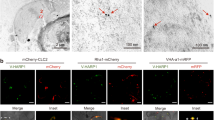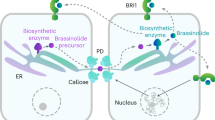Abstract
Receptor-mediated endocytosis is an integral part of signal transduction as it mediates signal attenuation and provides spatial and temporal dimensions to signaling events. One of the best-studied leucine-rich repeat receptor–like kinases in plants, BRASSINOSTEROID INSENSITIVE 1 (BRI1), perceives its ligand, the brassinosteroid (BR) hormone, at the cell surface and is constitutively endocytosed. However, the importance of endocytosis for BR signaling remains unclear. Here we developed a bioactive, fluorescent BR analog, Alexa Fluor 647–castasterone (AFCS), and visualized the endocytosis of BRI1–AFCS complexes in living Arabidopsis thaliana cells. Impairment of endocytosis dependent on clathrin and the guanine nucleotide exchange factor for ARF GTPases (ARF-GEF) GNOM enhanced BR signaling by retaining active BRI1-ligand complexes at the plasma membrane. Increasing the trans-Golgi network/early endosome pool of BRI1–BR complexes did not affect BR signaling. Our findings provide what is to our knowledge the first visualization of receptor-ligand complexes in plants and reveal clathrin- and ARF-GEF–dependent endocytic regulation of BR signaling from the plasma membrane.
This is a preview of subscription content, access via your institution
Access options
Subscribe to this journal
Receive 12 print issues and online access
$259.00 per year
only $21.58 per issue
Buy this article
- Purchase on Springer Link
- Instant access to full article PDF
Prices may be subject to local taxes which are calculated during checkout




Similar content being viewed by others
References
Scita, G. & Di Fiore, P.P. The endocytic matrix. Nature 463, 464–473 (2010).
Sorkin, A. & von Zastrow, M. Endocytosis and signalling: intertwining molecular networks. Nat. Rev. Mol. Cell Biol. 10, 609–622 (2009).
De Smet, I., Voss, U., Jurgens, G. & Beeckman, T. Receptor-like kinases shape the plant. Nat. Cell Biol. 11, 1166–1173 (2009).
Irani, N.G. & Russinova, E. Receptor endocytosis and signaling in plants. Curr. Opin. Plant Biol. 12, 653–659 (2009).
Li, J. & Chory, J. A putative leucine-rich repeat receptor kinase involved in brassinosteroid signal transduction. Cell 90, 929–938 (1997).
Friedrichsen, D.M., Joazeiro, C.A., Li, J., Hunter, T. & Chory, J. Brassinosteroid-insensitive-1 is a ubiquitously expressed leucine-rich repeat receptor serine/threonine kinase. Plant Physiol. 123, 1247–1256 (2000).
Kinoshita, T. et al. Binding of brassinosteroids to the extracellular domain of plant receptor kinase BRI1. Nature 433, 167–171 (2005).
Hothorn, M. et al. Structural basis of steroid hormone perception by the receptor kinase BRI1. Nature 474, 467–471 (2011).
She, J. et al. Structural insight into brassinosteroid perception by BRI1. Nature 474, 472–476 (2011).
Wang, X. & Chory, J. Brassinosteroids regulate dissociation of BKI1, a negative regulator of BRI1 signaling, from the plasma membrane. Science 313, 1118–1122 (2006).
Wang, X. et al. Sequential transphosphorylation of the BRI1/BAK1 receptor kinase complex impacts early events in brassinosteroid signaling. Dev. Cell 15, 220–235 (2008).
Russinova, E. et al. Heterodimerization and endocytosis of Arabidopsis brassinosteroid receptors BRI1 and AtSERK3 (BAK1). Plant Cell 16, 3216–3229 (2004).
Vert, G. & Chory, J. Downstream nuclear events in brassinosteroid signalling. Nature 441, 96–100 (2006).
Wang, Z.Y. et al. Nuclear-localized BZR1 mediates brassinosteroid-induced growth and feedback suppression of brassinosteroid biosynthesis. Dev. Cell 2, 505–513 (2002).
Gampala, S.S. et al. An essential role for 14–3-3 proteins in brassinosteroid signal transduction in Arabidopsis. Dev. Cell 13, 177–189 (2007).
Yin, Y. et al. BES1 accumulates in the nucleus in response to brassinosteroids to regulate gene expression and promote stem elongation. Cell 109, 181–191 (2002).
Geldner, N., Hyman, D.L., Wang, X., Schumacher, K. & Chory, J. Endosomal signaling of plant steroid receptor kinase BRI1. Genes Dev. 21, 1598–1602 (2007).
Dettmer, J., Hong-Hermesdorf, A., Stierhof, Y.D. & Schumacher, K. Vacuolar H+-ATPase activity is required for endocytic and secretory trafficking in Arabidopsis. Plant Cell 18, 715–730 (2006).
Viotti, C. et al. Endocytic and secretory traffic in Arabidopsis merge in the trans-Golgi network/early endosome, an independent and highly dynamic organelle. Plant Cell 22, 1344–1357 (2010).
Chen, X., Irani, N.G. & Friml, J. Clathrin-mediated endocytosis: the gateway into plant cells. Curr. Opin. Plant Biol. 14, 674–682 (2011).
Caño-Delgado, A. et al. BRL1 and BRL3 are novel brassinosteroid receptors that function in vascular differentiation in Arabidopsis. Development 131, 5341–5351 (2004).
González-García, M.P. et al. Brassinosteroids control meristem size by promoting cell cycle progression in Arabidopsis roots. Development 138, 849–859 (2011).
Tanaka, K. et al. Brassinosteroid homeostasis in Arabidopsis is ensured by feedback expressions of multiple genes involved in its metabolism. Plant Physiol. 138, 1117–1125 (2005).
Yang, X.H., Xu, Z.H. & Xue, H.W. Arabidopsis membrane steroid binding protein 1 is involved in inhibition of cell elongation. Plant Cell 17, 116–131 (2005).
Jaillais, Y., Fobis-Loisy, I., Miege, C. & Gaude, T. Evidence for a sorting endosome in Arabidopsis root cells. Plant J. 53, 237–247 (2008).
Geldner, N. et al. Rapid, combinatorial analysis of membrane compartments in intact plants with a multicolor marker set. Plant J. 59, 169–178 (2009).
Banbury, D.N., Oakley, J.D., Sessions, R.B. & Banting, G. Tyrphostin A23 inhibits internalization of the transferrin receptor by perturbing the interaction between tyrosine motifs and the medium chain subunit of the AP-2 adaptor complex. J. Biol. Chem. 278, 12022–12028 (2003).
Dhonukshe, P. et al. Clathrin-mediated constitutive endocytosis of PIN auxin efflux carriers in Arabidopsis. Curr. Biol. 17, 520–527 (2007).
Van Damme, D. et al. Adaptin-like protein TPLATE and clathrin recruitment during plant somatic cytokinesis occurs via two distinct pathways. Proc. Natl. Acad. Sci. USA 108, 615–620 (2011).
Robert, S. et al. ABP1 mediates auxin inhibition of clathrin-dependent endocytosis in Arabidopsis. Cell 143, 111–121 (2010).
Wang, X. et al. Identification and functional analysis of in vivo phosphorylation sites of the Arabidopsis BRASSINOSTEROID-INSENSITIVE1 receptor kinase. Plant Cell 17, 1685–1703 (2005).
Asami, T. et al. Characterization of brassinazole, a triazole-type brassinosteroid biosynthesis inhibitor. Plant Physiol. 123, 93–100 (2000).
Dhonukshe, P. et al. Generation of cell polarity in plants links endocytosis, auxin distribution and cell fate decisions. Nature 456, 962–966 (2008).
Geldner, N., Friml, J., Stierhof, Y.D., Jurgens, G. & Palme, K. Auxin transport inhibitors block PIN1 cycling and vesicle trafficking. Nature 413, 425–428 (2001).
Teh, O.K. & Moore, I. An ARF-GEF acting at the Golgi and in selective endocytosis in polarized plant cells. Nature 448, 493–496 (2007).
Richter, S. et al. Functional diversification of closely related ARF-GEFs in protein secretion and recycling. Nature 448, 488–492 (2007).
Geldner, N. et al. The Arabidopsis GNOM ARF-GEF mediates endosomal recycling, auxin transport, and auxin-dependent plant growth. Cell 112, 219–230 (2003).
Naramoto, S. et al. ADP-ribosylation factor machinery mediates endocytosis in plant cells. Proc. Natl. Acad. Sci. USA 107, 21890–21895 (2010).
Gupta, P.B. et al. Identification of selective inhibitors of cancer stem cells by high-throughput screening. Cell 138, 645–659 (2009).
Dinter, A. & Berger, E.G. Golgi-disturbing agents. Histochem. Cell Biol. 109, 571–590 (1998).
Clouse, S.D. Brassinosteroid signal transduction: from receptor kinase activation to transcriptional networks regulating plant development. Plant Cell 23, 1219–1230 (2011).
Wilde, A. et al. EGF receptor signaling stimulates SRC kinase phosphorylation of clathrin, influencing clathrin redistribution and EGF uptake. Cell 96, 677–687 (1999).
Orlandi, P.A. & Fishman, P.H. Filipin-dependent inhibition of cholera toxin: evidence for toxin internalization and activation through caveolae-like domains. J. Cell Biol. 141, 905–915 (1998).
Yano, K. et al. Contribution of the plasma membrane and central vacuole in the formation of autolysosomes in cultured tobacco cells. Plant Cell Physiol. 45, 951–957 (2004).
Dhonukshe, P. et al. Endocytosis of cell surface material mediates cell plate formation during plant cytokinesis. Dev. Cell 10, 137–150 (2006).
Song, L., Shi, Q.M., Yang, X.H., Xu, Z.H. & Xue, H.W. Membrane steroid-binding protein 1 (MSBP1) negatively regulates brassinosteroid signaling by enhancing the endocytosis of BAK1. Cell Res. 19, 864–876 (2009).
Barberon, M. et al. Monoubiquitin-dependent endocytosis of the iron-regulated transporter 1 (IRT1) transporter controls iron uptake in plants. Proc. Natl. Acad. Sci. USA 108, E450–E458 (2011).
Tang, W. et al. BSKs mediate signal transduction from the receptor kinase BRI1 in Arabidopsis. Science 321, 557–560 (2008).
De Rybel, B. et al. Chemical inhibition of a subset of Arabidopsis thaliana GSK3-like kinases activates brassinosteroid signaling. Chem. Biol. 16, 594–604 (2009).
Acknowledgements
We thank N. Geldner, Y. Yin, S. Clouse, Xiaofeng Wang, S. Huber and Xuelu Wang for sharing materials and protocols; S. Figaroli for technical assistance; M. De Cock for the help with manuscript preparation; and J. Martins for NMR and structure analysis. This work is supported by the Odysseus program of the Research Foundation-Flanders (to J.F.), the BRAVISSIMO Marie-Curie Initial Training Network (predoctoral fellowships to S.D.R. and J.S.-P.), the Research Foundation-Flanders (postdoctoral fellowship to D.V.D.), the Agency for Innovation by Science and Technology (postdoctoral fellowship to K.M.), the Research Foundation-Flanders (research grant to E.R.) and projects 1M06030 and Z4 055 0506 (to J.H., M.S. and L.K.). The 700-MHz equipment of the Interuniversitary NMR Facility used in this work was financed by Ghent University, the Free University of Brussels and the University of Antwerp via the 'Zware Apparatuur' Incentive of the Flemish Government.
Author information
Authors and Affiliations
Contributions
N.G.I., S.D.R., J.F. and E.R. conceived the study and designed the experiments. N.G.I., S.D.R., E.M., J.S.-P., A.-M.S., J.V.-B., K.M., M.-C.C. and D.V.D. performed experiments and analyzed the results. N.G.I., J.V.d.B., J.H., M.S., M.Š., L.K., D.B. and A.M. performed the chemical synthesis and analyzed the results. N.G.I., S.D.R., A.I.C.-D., D.V.D., A.M., J.F. and E.R. planned experiments and analyses. N.G.I., S.D.R., J.F. and E.R. wrote the manuscript. All authors commented on the results and the manuscript.
Corresponding author
Ethics declarations
Competing interests
The authors declare no competing financial interests.
Supplementary information
Supplementary Text and Figures
Supplementary Methods and Supplementary Results (PDF 7786 kb)
Rights and permissions
About this article
Cite this article
Irani, N., Di Rubbo, S., Mylle, E. et al. Fluorescent castasterone reveals BRI1 signaling from the plasma membrane. Nat Chem Biol 8, 583–589 (2012). https://doi.org/10.1038/nchembio.958
Received:
Accepted:
Published:
Issue Date:
DOI: https://doi.org/10.1038/nchembio.958
This article is cited by
-
Plasmodesmata mediate cell-to-cell transport of brassinosteroid hormones
Nature Chemical Biology (2023)
-
Endocytosis of root cells induced by low-dose lanthanum(III) can promote seedling photomorphogenesis and leaf photosynthesis
Plant and Soil (2023)
-
Rhizobia induce SYMRK endocytosis in Phaseolus vulgaris root hair cells
Planta (2023)
-
Local brassinosteroid biosynthesis enables optimal root growth
Nature Plants (2021)
-
Chaperone-like protein DAY plays critical roles in photomorphogenesis
Nature Communications (2021)



